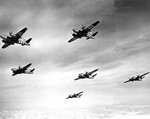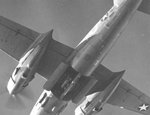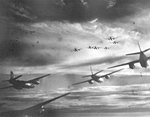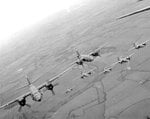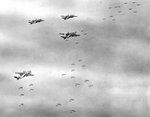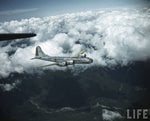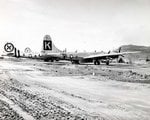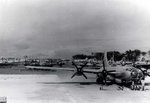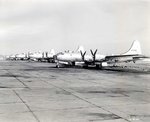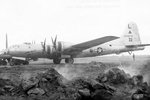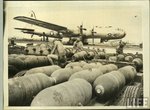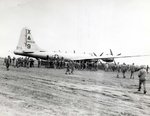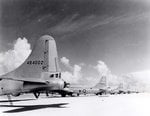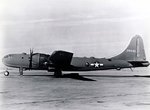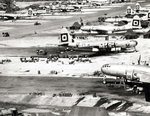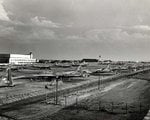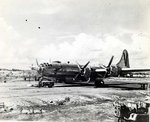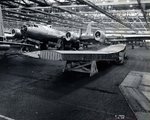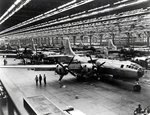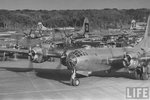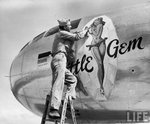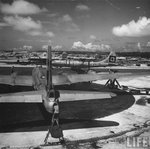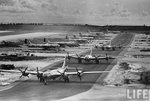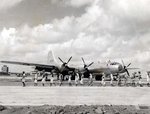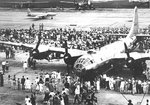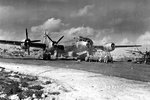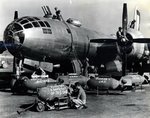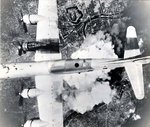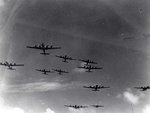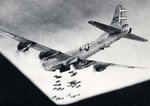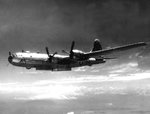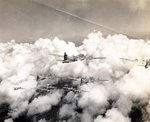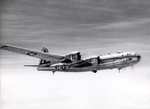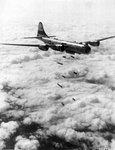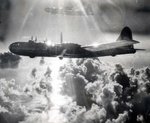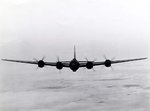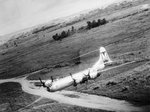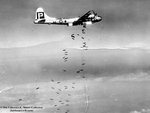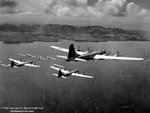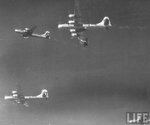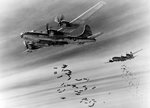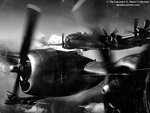- Thread starter
- #121
Navigation
Install the app
How to install the app on iOS
Follow along with the video below to see how to install our site as a web app on your home screen.
Note: This feature may not be available in some browsers.
More options
You are using an out of date browser. It may not display this or other websites correctly.
You should upgrade or use an alternative browser.
You should upgrade or use an alternative browser.
American bombers and transport aircrafts
- Thread starter gekho
- Start date
Ad: This forum contains affiliate links to products on Amazon and eBay. More information in Terms and rules
More options
Who Replied?- Thread starter
- #122
The XB-28 (North American model NA-63) was originally conceived as a high altitude version of the B-25 medium bomber. The resulting design, while maintaining the same overall configuration of the Mitchell (with the exception of a single vertical tail instead of B-25's twin tail), was visually more reminiscent of the B-26 Marauder. Other differences in the XB-28 design included a pressurized fuselage and three remote-controlled twin .50 caliber gun turrets (upper, lower, and tail). Two prototypes were ordered in February 1940, with the first flight taking place on April 26, 1942. After testing of the two prototypes, the project was canceled with no further examples being built. The reason for this, according to the USAF archives, was that "although the XB-28 was a successful design, the aircraft never went into production. One reason for this was high altitude bombing was too susceptible to errors caused by wind, cloud cover, etc. especially in the Pacific Theater of Operations. Another was the increasing effectiveness of medium bombers at low and medium levels along with improved tactics. Finally, the performance gains were not considered great enough to interrupt production of proven combat models." The second prototype XB-28 was built as a high altitude photo reconnaissance aircraft, and was designated XB-28A, but like the first XB-28 prototype it was the only one of its kind.
Attachments
Wildcat
Major
Sweet looking bird.
Good stuff!
vikingBerserker
Lieutenant General
That is nice looking.
- Thread starter
- #126
As early as 1934, Boeing began working on several prototypes (Model 322, 333A, 333B, 334A, and 341) with features that ultimately came together in the B-29, among them: a pressurized cabin, tricycle landing gear, long range under heavy bomb loads, etc.. As the war in Europe boiled, the Army issued a specification for the Very Long Range (VLR) "superbomber" in January 1940. It called for a speed of 400 MPH, a 5333 mile range, and a bomb load of 2000 pounds delivered at 2666 miles. With the work it had been doing, Boeing was at an advantage over the other competitors: Consolidated, Douglas, and Lockheed.
Even before the prototype was built, the Army ordered a second one, and then in the wake of Pearl Harbor, ordered a thousand more. Boeing dedicated its Renton factory to the B-29; the Glenn Martin Company started production in Omaha. To meet the specs of the VLR bomber noted above, Boeing designed the Model 345 - a four engine bomber with tricycle landing gear (folding into the huge engine nacelles), five gun turrets, and weighing almost 100,000 pounds. Submitted in May, 1940, the Model 345 won an Army to develop it into the XB-29 prototype. . By August, Douglas and Lockheed had dropped out, and the Army issued a contract to Consolidated for the XB-32, as a backup to Boeing's favored XB-29.
During 1941, the Army increased its order, from three prototypes, to fourteen, then 250, and then (after Pearl Harbor) 1500. All before the first prototype had flown! With the country on a wartime footing, three other factories were drawn into B-29 production (in addition to Boeing's own Wichita, Kansas plant): Bell Aircraft's factory in Marietta, Georgia; Glenn Martin in Omaha; Boeing-Renton, and GM's Fisher Body plant in Cleveland.
Even before the prototype was built, the Army ordered a second one, and then in the wake of Pearl Harbor, ordered a thousand more. Boeing dedicated its Renton factory to the B-29; the Glenn Martin Company started production in Omaha. To meet the specs of the VLR bomber noted above, Boeing designed the Model 345 - a four engine bomber with tricycle landing gear (folding into the huge engine nacelles), five gun turrets, and weighing almost 100,000 pounds. Submitted in May, 1940, the Model 345 won an Army to develop it into the XB-29 prototype. . By August, Douglas and Lockheed had dropped out, and the Army issued a contract to Consolidated for the XB-32, as a backup to Boeing's favored XB-29.
During 1941, the Army increased its order, from three prototypes, to fourteen, then 250, and then (after Pearl Harbor) 1500. All before the first prototype had flown! With the country on a wartime footing, three other factories were drawn into B-29 production (in addition to Boeing's own Wichita, Kansas plant): Bell Aircraft's factory in Marietta, Georgia; Glenn Martin in Omaha; Boeing-Renton, and GM's Fisher Body plant in Cleveland.
Attachments
- Thread starter
- #127
The XB-29 had wings that were as small as possible, with large radial engines outside them. While crew space fore and aft had to be pressurized, the bomb bays (with their huge doors) could not be. To deal with this problem, Boeing linked the front and rear pressurized sections with a sealed tunnel. The relatively small wings meant low drag but also very high wing-loading, double the desirable limit of 1940. Four Wright Cyclone 3350 engines with two turbosuperchargers each were able to handle the challenge. Problems like preventing guns and propeller mechanisms from freezing at high altitudes abounded. A very strong ring section connected the two wings and separated the two bomb bays.
At altitudes of 30,000 feet, manned gun turrets were impractical and Sperry developed retractable, periscopically directed, electrically powered turrets for the B-29. The normal crew of twelve included a pilot, co-pilot, bombardier, navigator, flight engineer, radio operator, radar operator, and five gunners. The first seven guys occupied the forward pressurized cabin. Four gunners were in the rear cabin, and the poor tail gunner was trapped in his own little pressurized pocket in the tail for the duration of the flight.
Boeing test pilot Edmund T. "Eddie" Allen made the first XB-29 flight in September, 1942. In the next few months, the engines' tendency to catch fire severely limited test flight time. In 23 test flights, they went through 16 engines, in only 27 hours of flight time. Under the urgent demands of war, a second prototype rolled out in December, 1942, and the project moved forward, unslowed even by the death of Eddie Allen and 30 others in a February crash. By mid-1943, the Wichita plant started to deliver the fourteen YB-29 service test aircraft to the 58th Bomb Wing. In the YB-29's, Sperry's turrets were replaced by non-retractable GE types, operated with computerized gunsights. The GE turrets could be operated with on eless gunner, but their demands for electrical power increased the weight of the aircraft to 105,000 pounds.
Two-thirds of the Superfortresses built were B-29's, with no letter suffix, just B-29. 2,513 of this variant were built: 1620 by Boeing-Wichita, 536 by Martin-Omaha, and 357 by Bell-Marietta. Powered by four 2200 hp Wright R-3350-23 radial engines driving 16-foot, 7-inch four-bladed propellers, the B-29 could cruise at 342 MPH at 30,000 feet. Over long distances, its economical cruising speed was 220 MPH at 25,000 feet. In September, 1943, the first B-29's rolled off the assembly line at Wichita, followed by deliveries from the other plants over the next several months. A few early B-29's were camouflage painted; the rest were left in natural metal finish. Thirty fuel tanks (in the wings and the bomb bay) carried over 9400 gallons of gasoline. Radar-assisted navigation and bombing sets helped the Superforts get to their targets and drop their bombs accurately.
Like most other bombers, the B-29's development was marked by an increase in defensive firepower, particularly from frontal attacks. In the B-29's case, the forward dorsal turret machine guns were increased from two to four. However, in the tail, the original 20mm cannon was removed, because its shells' trajectory was so different from the 50 caliber machine guns' that it made aiming difficult.
At altitudes of 30,000 feet, manned gun turrets were impractical and Sperry developed retractable, periscopically directed, electrically powered turrets for the B-29. The normal crew of twelve included a pilot, co-pilot, bombardier, navigator, flight engineer, radio operator, radar operator, and five gunners. The first seven guys occupied the forward pressurized cabin. Four gunners were in the rear cabin, and the poor tail gunner was trapped in his own little pressurized pocket in the tail for the duration of the flight.
Boeing test pilot Edmund T. "Eddie" Allen made the first XB-29 flight in September, 1942. In the next few months, the engines' tendency to catch fire severely limited test flight time. In 23 test flights, they went through 16 engines, in only 27 hours of flight time. Under the urgent demands of war, a second prototype rolled out in December, 1942, and the project moved forward, unslowed even by the death of Eddie Allen and 30 others in a February crash. By mid-1943, the Wichita plant started to deliver the fourteen YB-29 service test aircraft to the 58th Bomb Wing. In the YB-29's, Sperry's turrets were replaced by non-retractable GE types, operated with computerized gunsights. The GE turrets could be operated with on eless gunner, but their demands for electrical power increased the weight of the aircraft to 105,000 pounds.
Two-thirds of the Superfortresses built were B-29's, with no letter suffix, just B-29. 2,513 of this variant were built: 1620 by Boeing-Wichita, 536 by Martin-Omaha, and 357 by Bell-Marietta. Powered by four 2200 hp Wright R-3350-23 radial engines driving 16-foot, 7-inch four-bladed propellers, the B-29 could cruise at 342 MPH at 30,000 feet. Over long distances, its economical cruising speed was 220 MPH at 25,000 feet. In September, 1943, the first B-29's rolled off the assembly line at Wichita, followed by deliveries from the other plants over the next several months. A few early B-29's were camouflage painted; the rest were left in natural metal finish. Thirty fuel tanks (in the wings and the bomb bay) carried over 9400 gallons of gasoline. Radar-assisted navigation and bombing sets helped the Superforts get to their targets and drop their bombs accurately.
Like most other bombers, the B-29's development was marked by an increase in defensive firepower, particularly from frontal attacks. In the B-29's case, the forward dorsal turret machine guns were increased from two to four. However, in the tail, the original 20mm cannon was removed, because its shells' trajectory was so different from the 50 caliber machine guns' that it made aiming difficult.
Attachments
- Thread starter
- #128
After the Casablanca Conference in early 1943, President Roosevelt committed the United States to a heavy bombing campaign against Japan, at the earliest possible date. The B-29 was the only bomber with the range and payload needed; thus Roosevelt constantly hammered General Hap Arnold to deliver the big bomber. As plans for Operation Matterhorn took shape, they envisaged basing the B-29's in eastern India, flying them over "the Hump," staging/refueling at Chengtu in central China, and then bombing Japanese cities.
But the bombers weren't ready, not in January, 1994 as Roosevelt had hoped. Training the crews in the complex new aircraft proved to be a major challenge. By the beginning of 1944, only 73 pilots had qualified for the B-29, and although 97 B-29s had been produced, only 16 were combat ready. Engine fires continued to be a problem and the radar equipment proved to be very touchy. While the USAAF had set up the XX Bomber Command to take over the B-29 program, by early, 1944 it was still a shambles, with most planes stuck at the modification centers. In March, Major General B.E. Meyer was appointed to head up the modification program, and thus commenced "the Battle of Kansas." Mobilizing the vast industrial resources of the United States, workers were brought in to work round the clock, outdoors in the freezing Kansas winter weather if necessary, to get some B-29's delivered. By mid April, they had turned over 150.
In April, 1944, B-29's began arriving at their bases in Bengal, India: Kharagpur, Chakulia, Piardoba, and Dudkhundi. At the same time, the 20th Air Force, an independent command, was established, largely to prevent local commanders like Stilwell and Chennault from diverting the B-29's away from their primary mission - bombing Japan. Engines continued to overheat and catch fire, a tendency exacerbated by the 115 degree heat of India. The engineers designed new baffles and cowl flaps to direct cooling air onto the overheated rear cylinders. In early April, the B-29's were blooded when six Ki-43 Hayabusa fighters jumped some that were flying fuel into Chengtu. By May, 130 Superfortresses had reached India and the staging bases near Chengtu, China were usable, if barely so. But forwarding the needed fuel and bombs to Chengtu over "the Hump" was hazardous and inefficient.
On June 5, the Superforts made their first bombing attack, against the rail yards at Bangkok. Balky engines and bad weather conspired to cripple the mission. Only eighteen bombs hit the target. Not a good start. Washington continued to pressure General Wolfe, CO of XX Bomber Command, to attack Japan itself by the middle of the month. On the night of June 14-15, ninety-two B-29's took off from staging bases in China, to strike at the Imperial Iron and Steel Works at Yawata on Kyushu - a vital target that turned out a quarter of Japan's rolled steel. The diminishing number of bombers at each stage of the mission illustrates the problems inherent in Operation Matterhorn:
* 92 bombers left India.
* 79 reached the staging bases in China.
* 75 took off from the bases.
* 68 left China, the others aborted after take-off.
* 47 reached the target at Yawata.
* 15 bombed visually; 32 bombed by radar due to the weather.
* One bomb hit the target!
Despite the failure of the raid in material damage, the press hailed it as a great victory; it was the first American bombing raid to hit Japan since the Doolittle Raid in April, 1942. The Matterhorn raids continued. Eighteen bombers hit Japanes cities on July 7. Two days later, 72 Superforts were launched against a steel plant in Manchuria. More ineffective raids were staged in August.
General Curtis LeMay, only 38 years old, arrived on August 29, to head up XX Bomber Command. A cigar-chomping tough guy, LeMay shook things up. He increased training and mission frequency; he re-organized the flights into 12-plane boxes; he introduced the 'lead bomber' concept; and he re-organized the Bomb Groups. Raids continued through the fall, hampered by supply problems and more effective Japanese air defenses. By the end of 1944, 147 Superfortresses had been lost to enemy guns and to accidents. Operation Matterhorn wasn't working and it was phased out.
But the bombers weren't ready, not in January, 1994 as Roosevelt had hoped. Training the crews in the complex new aircraft proved to be a major challenge. By the beginning of 1944, only 73 pilots had qualified for the B-29, and although 97 B-29s had been produced, only 16 were combat ready. Engine fires continued to be a problem and the radar equipment proved to be very touchy. While the USAAF had set up the XX Bomber Command to take over the B-29 program, by early, 1944 it was still a shambles, with most planes stuck at the modification centers. In March, Major General B.E. Meyer was appointed to head up the modification program, and thus commenced "the Battle of Kansas." Mobilizing the vast industrial resources of the United States, workers were brought in to work round the clock, outdoors in the freezing Kansas winter weather if necessary, to get some B-29's delivered. By mid April, they had turned over 150.
In April, 1944, B-29's began arriving at their bases in Bengal, India: Kharagpur, Chakulia, Piardoba, and Dudkhundi. At the same time, the 20th Air Force, an independent command, was established, largely to prevent local commanders like Stilwell and Chennault from diverting the B-29's away from their primary mission - bombing Japan. Engines continued to overheat and catch fire, a tendency exacerbated by the 115 degree heat of India. The engineers designed new baffles and cowl flaps to direct cooling air onto the overheated rear cylinders. In early April, the B-29's were blooded when six Ki-43 Hayabusa fighters jumped some that were flying fuel into Chengtu. By May, 130 Superfortresses had reached India and the staging bases near Chengtu, China were usable, if barely so. But forwarding the needed fuel and bombs to Chengtu over "the Hump" was hazardous and inefficient.
On June 5, the Superforts made their first bombing attack, against the rail yards at Bangkok. Balky engines and bad weather conspired to cripple the mission. Only eighteen bombs hit the target. Not a good start. Washington continued to pressure General Wolfe, CO of XX Bomber Command, to attack Japan itself by the middle of the month. On the night of June 14-15, ninety-two B-29's took off from staging bases in China, to strike at the Imperial Iron and Steel Works at Yawata on Kyushu - a vital target that turned out a quarter of Japan's rolled steel. The diminishing number of bombers at each stage of the mission illustrates the problems inherent in Operation Matterhorn:
* 92 bombers left India.
* 79 reached the staging bases in China.
* 75 took off from the bases.
* 68 left China, the others aborted after take-off.
* 47 reached the target at Yawata.
* 15 bombed visually; 32 bombed by radar due to the weather.
* One bomb hit the target!
Despite the failure of the raid in material damage, the press hailed it as a great victory; it was the first American bombing raid to hit Japan since the Doolittle Raid in April, 1942. The Matterhorn raids continued. Eighteen bombers hit Japanes cities on July 7. Two days later, 72 Superforts were launched against a steel plant in Manchuria. More ineffective raids were staged in August.
General Curtis LeMay, only 38 years old, arrived on August 29, to head up XX Bomber Command. A cigar-chomping tough guy, LeMay shook things up. He increased training and mission frequency; he re-organized the flights into 12-plane boxes; he introduced the 'lead bomber' concept; and he re-organized the Bomb Groups. Raids continued through the fall, hampered by supply problems and more effective Japanese air defenses. By the end of 1944, 147 Superfortresses had been lost to enemy guns and to accidents. Operation Matterhorn wasn't working and it was phased out.
Attachments
Nice shots!
vikingBerserker
Lieutenant General
Nice!
- Thread starter
- #132
U.S. military planners had realized quite early that the Marianas (Saipan, Tinian, and Guam), located about 1500 south of Tokyo would be useful bases from which to launch B-29 attacks against Japan. In the summer of 1944, the Marianas were secured and airfields were quickly built. XXI Bomber Command was organized for the Marianas B-29 operations. After the planes were brought in, the crews trained, and some preliminary raids, 111 Superforts bombed the Nakajima Aircraft Company's Musashi engine plant near Tokyo on November 20, 1944. Largely ineffective raids continued against the Musashi plant and the Mitsubishi engine plant at Nagoya through the end of the year. Once again the Joint Chiefs called in Curtis LeMay to take over. He had analyzed the Japanese economy and focused on its dependence on small cottage industries spread throughout the large cities. Since the previous afforts at high-level precision, daylight bombing of specific targets had failed, LeMay instead proposed to burn out the Japanese cities entirely, destroying the critical industries (and the civilian population) in the process. (Not exactly the way we wage war now, where every errant bomb that hits an Afghan camel must be accounted for.)
LeMay developed a radically different approach. First, the bombers would carry incendiary, rather than high explosive, bombs. To save fuel and maximize the bomb load, the guns were stripped out, the Superforts would fly at 5,000 (instead of 30,000) feet, and each plane would fly directly to the target (no more circling and joining up in formation). These allowed each Superfort to carry about seven tons of M69 incendiary bombs. Lastly, they would go at night, since precision was no longer required and because Japanese night fighter forces were not very good.
The results were devastating. On the night of March 9-10, 279 B-29's bombed Tokyo. A huge firestorm resulted, sixteen square miles of Tokyo were reduced to ashes and 84,000 Japanese were killed. In the next week, similar, but less destructive, results were obtained in Nagoya, Osaka, and Kobe. Only twenty B-29s were lost. XXI Bomber Command exhausted its supply of incendiaries for a while, but when resupplied in April continued the terrible raids with awesome fury. The industrial areas of Tokyo, Nagoya, Osaka, Kawasaki, Kobe, and Yokohama were reduced to ashes. The aircraft engine factories (or their general areas) were hit again with incendiary bombing. By mid-April, Japanese aircraft engine manufacturing capability had been wiped out. The incendiary raids continued through June, reducing Japans' six largest cities to ashes. Kobe was so thoroughly gutted that it was removed from the target list. B-29 Hunters of the JAAF (Osprey Aviation Elite 5) by Koji Takaki, Henry Sakaida B-29 Hunters of the JAAF. More B-29's arrived in the Marianas, including those from the former XX Bomber Command and some B-29B's, specifically lightened for nighttime pathfinding. The Superfortress missions expanded to include mining the Inland Sea and firebombing 58 smaller cities. The Japanese fighter forces had been routed. Almost unopposed, the B-29's began dropping leaflets three days in advance of their incendiary raids, advising inhabitants of their city's impending destruction.
LeMay developed a radically different approach. First, the bombers would carry incendiary, rather than high explosive, bombs. To save fuel and maximize the bomb load, the guns were stripped out, the Superforts would fly at 5,000 (instead of 30,000) feet, and each plane would fly directly to the target (no more circling and joining up in formation). These allowed each Superfort to carry about seven tons of M69 incendiary bombs. Lastly, they would go at night, since precision was no longer required and because Japanese night fighter forces were not very good.
The results were devastating. On the night of March 9-10, 279 B-29's bombed Tokyo. A huge firestorm resulted, sixteen square miles of Tokyo were reduced to ashes and 84,000 Japanese were killed. In the next week, similar, but less destructive, results were obtained in Nagoya, Osaka, and Kobe. Only twenty B-29s were lost. XXI Bomber Command exhausted its supply of incendiaries for a while, but when resupplied in April continued the terrible raids with awesome fury. The industrial areas of Tokyo, Nagoya, Osaka, Kawasaki, Kobe, and Yokohama were reduced to ashes. The aircraft engine factories (or their general areas) were hit again with incendiary bombing. By mid-April, Japanese aircraft engine manufacturing capability had been wiped out. The incendiary raids continued through June, reducing Japans' six largest cities to ashes. Kobe was so thoroughly gutted that it was removed from the target list. B-29 Hunters of the JAAF (Osprey Aviation Elite 5) by Koji Takaki, Henry Sakaida B-29 Hunters of the JAAF. More B-29's arrived in the Marianas, including those from the former XX Bomber Command and some B-29B's, specifically lightened for nighttime pathfinding. The Superfortress missions expanded to include mining the Inland Sea and firebombing 58 smaller cities. The Japanese fighter forces had been routed. Almost unopposed, the B-29's began dropping leaflets three days in advance of their incendiary raids, advising inhabitants of their city's impending destruction.
Attachments
- Thread starter
- #133
Long before the incendiary raids began to devastate Japan, the United States had been developing the atomic bomb. The Manhattan Project, in highest secrecy during 1943 and 1944, built two such bombs, a plutonium bomb dubbed "Fat Man," and a uranium bomb, "Little Boy." The 509th Composite Group was charged with delivering the new bombs, in specially modified B-29's, each capable of carrying and releasing a 10,000 pound atomic bomb. Commanded by Colonel Paul W. Tibbets, Jr., the men of the 509th knew nothing of their proposed mission. Nonetheless, they trained for their secret mission at Wendover, Utah before shipping out to Tinian, where they endured a lot of ribbing from guys in other units, "Oh, yeah, the 509th is gonna win the war."
After the first successful test of an atomic bomb on July 16, 1945 at Alamogordo, New Mexico, planning accelerated, and the Allies were informed, although Soviet spies had already kept Stalin fully apprised of developments. On July 26th, the Potsdam Declaration, an ultimatum which promised prompt and utter destruction, was issued to the Japanese. Well aware of the huge casualties that the Allies would incur in an invasion of Japan and determined to shorten the war, President Truman gave General Carl Spaatz the go-ahead to drop the atomic bomb. "Fat Man" and "Little Boy" were delivered to Tinian by USS Indianapolis and by C-54 transport planes. On August 6, 1945, the Enola Gay dropped "Little Boy" on Hiroshima. 75,000 people died and almost 50,000 buildings were destroyed. (Read more about Tibbets, the Enola Gay, and this mission.)
The Allies had expected, or perhaps hoped, that Japan would surrender after suffering the effects of an atomic bomb. But the Japanese government could not commit itself to surrender so quickly. In part they did not understand what had happened; in Tokyo all that was immediately certain was that all communications with Hiroshima had stopped. While the Japanes cabinet debated, conventional B-29 raids continued, in ever increasing force. Three days later, with no response from the Japanese, we dropped "Fat Man" on Nagasaki. (Personally, I try to avoid second guessing, and I am convinced that dropping the atomic bomb was the right decision, and that it ultimately saved both American and Japanese lives. But I do wonder if we should have let a few more days pass before dropping that second one. I guess by August of 1945, we were tired of war.) But it worked. That day the Soviets declared war on Japan and invaded Manchuria. The Emperor ordered the government to surrender. He broadcast word of the surrender to the Japanese people on August 15, and it was signed on the decks of the USS Missouri on September 2, 1945. The B-29's last missions of the war consisted of mercy food drops to POW camps.
After the first successful test of an atomic bomb on July 16, 1945 at Alamogordo, New Mexico, planning accelerated, and the Allies were informed, although Soviet spies had already kept Stalin fully apprised of developments. On July 26th, the Potsdam Declaration, an ultimatum which promised prompt and utter destruction, was issued to the Japanese. Well aware of the huge casualties that the Allies would incur in an invasion of Japan and determined to shorten the war, President Truman gave General Carl Spaatz the go-ahead to drop the atomic bomb. "Fat Man" and "Little Boy" were delivered to Tinian by USS Indianapolis and by C-54 transport planes. On August 6, 1945, the Enola Gay dropped "Little Boy" on Hiroshima. 75,000 people died and almost 50,000 buildings were destroyed. (Read more about Tibbets, the Enola Gay, and this mission.)
The Allies had expected, or perhaps hoped, that Japan would surrender after suffering the effects of an atomic bomb. But the Japanese government could not commit itself to surrender so quickly. In part they did not understand what had happened; in Tokyo all that was immediately certain was that all communications with Hiroshima had stopped. While the Japanes cabinet debated, conventional B-29 raids continued, in ever increasing force. Three days later, with no response from the Japanese, we dropped "Fat Man" on Nagasaki. (Personally, I try to avoid second guessing, and I am convinced that dropping the atomic bomb was the right decision, and that it ultimately saved both American and Japanese lives. But I do wonder if we should have let a few more days pass before dropping that second one. I guess by August of 1945, we were tired of war.) But it worked. That day the Soviets declared war on Japan and invaded Manchuria. The Emperor ordered the government to surrender. He broadcast word of the surrender to the Japanese people on August 15, and it was signed on the decks of the USS Missouri on September 2, 1945. The B-29's last missions of the war consisted of mercy food drops to POW camps.
Attachments
- Thread starter
- #134
Wildcat
Major
Love that last shot 
I always thought if we dropped pictures like the ones above, showing our economic might, over enemy territory the war might have been a little shorter...if even by 5 minutes. 
- Thread starter
- #137
More pics
Attachments
- Thread starter
- #138
More pics
Attachments
- Thread starter
- #139
More pics
Attachments
- Thread starter
- #140
Users who are viewing this thread
Total: 1 (members: 0, guests: 1)

